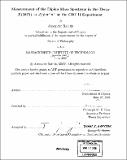Measurement of the dipion mass spectrum in the decay X(3872) [right arrow] J/ [psi] [pi]⁺ [pi]⁻ at the CDFII experiment
Author(s)
Rakitin, Alexander (Alexander Yurevich)
DownloadFull printable version (10.69Mb)
Other Contributors
Massachusetts Institute of Technology. Dept. of Physics.
Advisor
Christopher M.E. Paus.
Terms of use
Metadata
Show full item recordAbstract
We present a measurement of the dipion mass spectrum in the decay X(3872) [right arrow] J/ [psi] [pi]⁺ [pi]⁻ using a 360 pb-1 sample of pp collisions at av [square root]s = 1.96 TeV collected with the CDF II detector at the Fermnilab Tevatron Collider. As a benchmark, we also extract the dipion mass distribution for [psi] (2s) [right arrow] J/ [psi] [pi]⁺ [pi]⁻ decay. The X(3872) dipion mass spectrum is compared to QCD multipole expansion predictions for various charmonium states, as well as to the hypothesis [right arrow] J/ [psi] po. We find that the measured spectrum is compatible with 3S1 charmonium decaying to J/ [psi] [pi]⁺ [pi]⁻ - and with the X(3872) - J/po hypothesis. There is, however, no 3S1 charmonium state available for assignment to the X(3872). The multipole expansion calculations for 1P1 and 3DJ states are in clear disagreement with the X(3872) data. For the [psi] (2S) the data agrees well with previously published results and to multipole expansion calculations for 3S1 charmonium. Other, non-charmonium, models for the X(3872) are described too. We conclude that since the dipion mass spectrum for X(3872) is compatible with J/pO hypothesis, the X(3872) should be C-positive. This conclusion is supported by recent results from Belle Collaboration which observed X(3872) -+ J/7y decay. We argue that if X(3872) is a charmonium, then it should be either ... state, decaying into J/ [psi] [pi]⁺ [pi]⁻ in violation of isospin conservation. A non-charmonium assignment, such as DD* molecule, is also quite possible.
Description
Thesis (Ph. D.)--Massachusetts Institute of Technology, Dept. of Physics, 2005. In title on t.p., "[right arrow]" is the symbol; "[psi]" is the lower-case Greek letter; and, "[pi]" is the lower-case Greek letter. Includes bibliographical references (leaves 147-157).
Date issued
2005Department
Massachusetts Institute of Technology. Department of PhysicsPublisher
Massachusetts Institute of Technology
Keywords
Physics.
